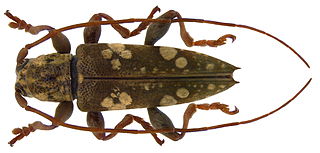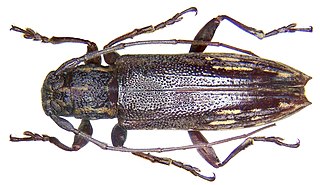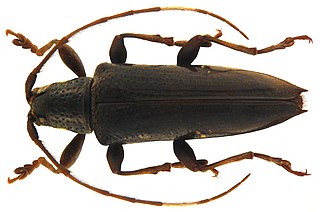| Disternopsis | |
|---|---|
| Scientific classification | |
| Kingdom: | |
| Phylum: | |
| Class: | |
| Order: | |
| Family: | |
| Subfamily: | |
| Genus: | Disternopsis Breuning, 1939 [1] |
| Type species | |
| Disternopsis pruinosa (Boisduval, 1835) | |
Disternopsis is a genus of longhorn beetles of the subfamily Lamiinae, [2] containing the following species:
A genus is a taxonomic rank used in the biological classification of living and fossil organisms, as well as viruses, in biology. In the hierarchy of biological classification, genus comes above species and below family. In binomial nomenclature, the genus name forms the first part of the binomial species name for each species within the genus.

The longhorn beetles are a cosmopolitan family of beetles, typically characterized by extremely long antennae, which are often as long as or longer than the beetle's body. In various members of the family, however, the antennae are quite short and such species can be difficult to distinguish from related beetle families such as the Chrysomelidae. The family is large, with over 26,000 species described, slightly more than half from the Eastern Hemisphere. Several are serious pests. The larvae, called roundheaded borers, bore into wood, where they can cause extensive damage to either living trees or untreated lumber. A number of species mimic ants, bees, and wasps, though a majority of species are cryptically colored. The rare titan beetle from northeastern South America is often considered the largest insect, with a maximum known body length of just over 16.7 cm (6.6 in). The scientific name of this beetle family goes back to a figure from Greek mythology: after an argument with nymphs, the shepherd Cerambus was transformed into a large beetle with horns.

Lamiinae, commonly called flat-faced longhorns, are a subfamily of the longhorn beetle family (Cerambycidae). The subfamily includes over 750 genera, rivaled in diversity within the family only by the subfamily Cerambycinae.
- Disternopsis albosticta Breuning, 1939
- Disternopsis apicespinosa Breuning, 1939
- Disternopsis bivittata Breuning, 1939
- Disternopsis bivittipennis Breuning, 1968
- Disternopsis metallica (Westwood, 1863)
- Disternopsis pentheoides (Pascoe, 1859)
- Disternopsis pruinosa (Boisduval, 1835)
Disternopsis albosticta is a species of beetle in the family Cerambycidae. It was described by Stephan von Breuning in 1939. It is known from Australia.
Disternopsis apicespinosa is a species of beetle in the family Cerambycidae. It was described by Stephan von Breuning in 1939. It is known from Australia.
Disternopsis bivittata is a species of beetle in the family Cerambycidae. It was described by Stephan von Breuning in 1939. It is known from Australia.





